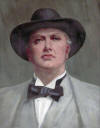




The Early History of Stowlawn by Frank Sharman
Part 5
The council then started on a modern up-to-date, whizz bang, socialist
approach to the Stowlawn estate.
The council engaged Sir Charles Reilly and Dr. Otto Neurath. What the
relationship between the two men was supposed to be is not clear but in the
event it seems that Reilly was the main man drawing up the plans for the estate;
and Neurath was consulted mainly on housing policy – something which would have
fed into the estate design.
 |
.jpg) |
.jpg) |
| Sir Charles Reilly | Otto Neurath |
Marie Neurath |
What Reilly did
- Professor Sir Charles Reilly (by now Emeritus Professor), was born 1874, the son of an architect. After attending Cambridge University he became an architect and was appointed Professor of Architecture at Liverpool University (aged 30) in 1904. Through his writings he promoted the idea of “civic design” or “town planning” . He retired from the university in 1933 and became a consultant on architecture and planning. He was knighted 1944. He was appointed at Bilston about 1944, aged 70. In making this appointment Bilston was again going for a big name who had ideas about council housing which largely coincided with their own.
Reilly’s ideas on suburban communities were espoused by the
left and far left. The Labour Party conference of 1944 recommended them for
general adoption and Aneurin Bevan especially supported the idea of creating
communities rather than estates.
The chief feature of Reilly’s plans was
that the houses should be built around greens, somewhat in the style of a
village green, which Reilly seems to have seen as an archetype of a good
community. He seems to have thought that the greens would promote interaction
between people living around them. The greens were to be generally oval but not
regular, and of different sizes but with some large enough to contain football
or cricket pitches. Each green would have 500 to 1000 people living round it.
Each green would have a club, which contained a library, reading rooms,
billiards room and catering facilities – to which families could go to eat or
from which they could order meals to be delivered (so each house had to have a
telephone). Reilly also wanted district heating and waste disposal by means of a
suction system which drew away all waste from each house to a central point.
Reilly called in a number of architects to work with him on
the design details, apparently getting one architect to work on each green. One
of these architects was Clough Williams Ellis who set to work with great
enthusiasm and it would have been interesting to see what this unusual architect
and founder of Port Meirion might have come up with had he not got bored and
resigned from the project. Another of the architects was Ella Briggs. It is said
that A V Williams had already asked her to design 160 houses for Stowlawn before
Reilly appeared on the scene. If that is so then Reilly probably took her into
the team and he assigned her the Lawnside green to work on.
Ella Briggs
was, like Otto and Marie Neurath, an emigree from Vienna, who whilst in Vienna,
had worked with Neurath and others on council housing.
Continues in Part 6 What Otto
Neurath did

.jpg)
.jpg)